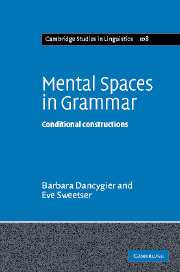Book contents
- Frontmatter
- Contents
- Acknowledgments
- Preface
- Note on abbreviated citations
- The door-scraper in the Wild Wood: an informal lesson in frame metonymy
- 1 Conditional constructions, mental spaces, and semantic compositionality
- 2 Prediction, alternativity, and epistemic stance
- 3 Tense, epistemic distance, and embedded spaces
- 4 Future and present forms in conditional constructions
- 5 Non-alternatives and alternatives: mental spaces in different domains
- 6 Then and even if: mental-space deixis and referential uniqueness
- 7 Clause order and space building: if, because, unless, and except if
- 8 Uniqueness and negative stance: only if and if only
- 9 Coordinate constructions and conditional meaning
- 10 The door-scraper in the Wild Wood: conditional constructions and frame-based space building
- References
- Author index
- Subject index
4 - Future and present forms in conditional constructions
Published online by Cambridge University Press: 22 September 2009
- Frontmatter
- Contents
- Acknowledgments
- Preface
- Note on abbreviated citations
- The door-scraper in the Wild Wood: an informal lesson in frame metonymy
- 1 Conditional constructions, mental spaces, and semantic compositionality
- 2 Prediction, alternativity, and epistemic stance
- 3 Tense, epistemic distance, and embedded spaces
- 4 Future and present forms in conditional constructions
- 5 Non-alternatives and alternatives: mental spaces in different domains
- 6 Then and even if: mental-space deixis and referential uniqueness
- 7 Clause order and space building: if, because, unless, and except if
- 8 Uniqueness and negative stance: only if and if only
- 9 Coordinate constructions and conditional meaning
- 10 The door-scraper in the Wild Wood: conditional constructions and frame-based space building
- References
- Author index
- Subject index
Summary
When a Brandy flutters her eyelashes, you can almost feel the breeze.
(NS. SC.63)Verb forms and constructional meaning
A wide variety of verb forms interact with predictive conditional constructions, making differing contributions to the overall meaning. In Chapters 2 and 3, we discussed the uses of particular verb forms to mark predictive reasoning and epistemic stance in conditionals. In Chapter 5, we will show that such verb-form restrictions are largely relaxed if the conditional is not used predictively; however, readers with detailed knowledge of the descriptive categories used in good grammars will already have noted gaps in our description of predictive conditionals. Chapter 2 did not mention alternate possible future verb forms in conditional apodoses; will and gonna are both possible in future predictive Q-clauses. We have not discussed generic conditionals: examples such as He gets angry if I leave the house (AT.AT.54) show two apparently present-tense verb forms. In this chapter, we will survey some of the regular functions of different verb forms in English conditional constructions.
In assessing the contributions of particular verb forms to the overall meaning of a conditional construction, we are necessarily concerned with the issue of how predictable this contribution is. In some cases, we will argue that the semantics of the relevant class of verbs simply makes a regular contribution to the compositional interpretation of the broader construction.
- Type
- Chapter
- Information
- Mental Spaces in GrammarConditional Constructions, pp. 80 - 109Publisher: Cambridge University PressPrint publication year: 2005
- 2
- Cited by



